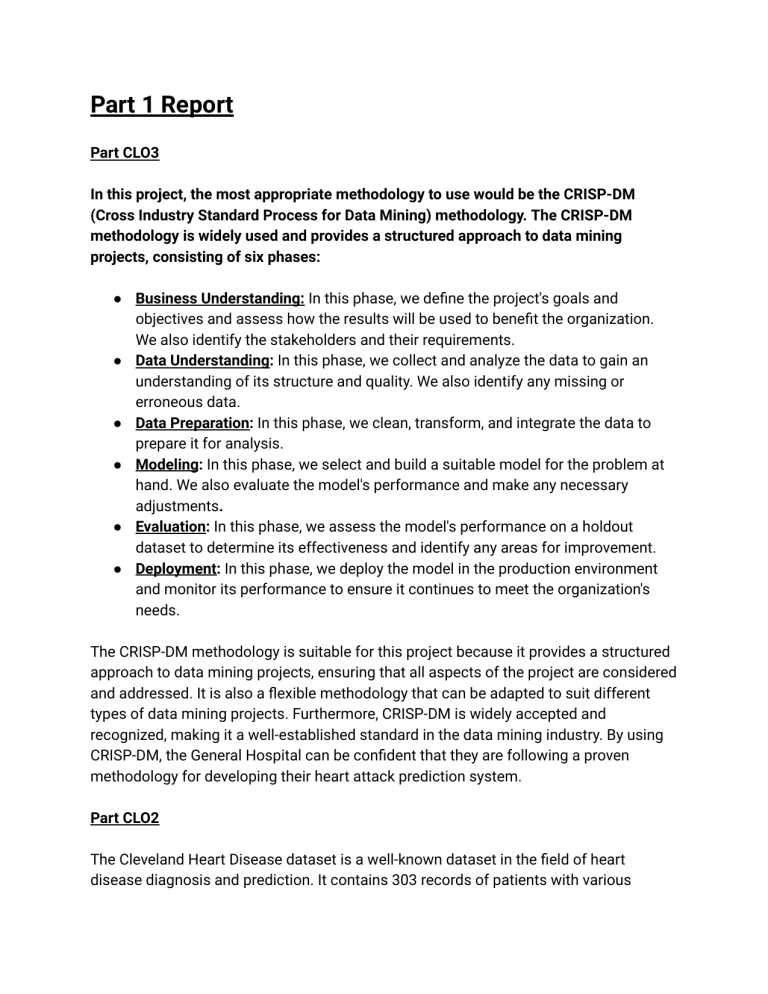Heart Disease Prediction with CRISP-DM & Cleveland Dataset
advertisement

Part 1 Report Part CLO3 In this project, the most appropriate methodology to use would be the CRISP-DM (Cross Industry Standard Process for Data Mining) methodology. The CRISP-DM methodology is widely used and provides a structured approach to data mining projects, consisting of six phases: ● Business Understanding: In this phase, we define the project's goals and objectives and assess how the results will be used to benefit the organization. We also identify the stakeholders and their requirements. ● Data Understanding: In this phase, we collect and analyze the data to gain an understanding of its structure and quality. We also identify any missing or erroneous data. ● Data Preparation: In this phase, we clean, transform, and integrate the data to prepare it for analysis. ● Modeling: In this phase, we select and build a suitable model for the problem at hand. We also evaluate the model's performance and make any necessary adjustments. ● Evaluation: In this phase, we assess the model's performance on a holdout dataset to determine its effectiveness and identify any areas for improvement. ● Deployment: In this phase, we deploy the model in the production environment and monitor its performance to ensure it continues to meet the organization's needs. The CRISP-DM methodology is suitable for this project because it provides a structured approach to data mining projects, ensuring that all aspects of the project are considered and addressed. It is also a flexible methodology that can be adapted to suit different types of data mining projects. Furthermore, CRISP-DM is widely accepted and recognized, making it a well-established standard in the data mining industry. By using CRISP-DM, the General Hospital can be confident that they are following a proven methodology for developing their heart attack prediction system. Part CLO2 The Cleveland Heart Disease dataset is a well-known dataset in the field of heart disease diagnosis and prediction. It contains 303 records of patients with various attributes related to heart disease, such as age, sex, cholesterol levels, chest pain type, and ECG measurements. The goal of the dataset is to predict the presence of heart disease in patients based on their attributes. The target variable is a binary variable indicating whether a patient has heart disease or not. This dataset has been widely used in research and machine learning models development related to heart disease prediction. The Cleveland Heart Disease dataset is a valuable resource for researchers and medical professionals in the field of cardiology. It has contributed significantly to the development of various heart disease prediction models and the understanding of the factors that contribute to heart disease. Part CLO5 Q3 here are the tasks that can be applied to each phase of the CRISP-DM methodology for the Cleveland Heart Disease dataset, along with the reason for each task: Define the problem: Define the problem that we are trying to solve with the heart disease prediction system. The reason for this task is to establish the objectives of the project and to ensure that we are addressing the key requirements of the stakeholders. Identify the goals: Identify the specific goals and success criteria for the project. The reason for this task is to ensure that the project is aligned with the organization's strategic objectives. Collect data: Collect the data related to the heart disease diagnosis and prediction from various sources, including the Cleveland Heart Disease dataset. The reason for this task is to ensure that we have the data needed to build a robust heart disease prediction model. Explore data: Explore the data to understand its structure, quality, and completeness. The reason for this task is to identify any data quality issues that need to be addressed before building the model. Verify data quality: Verify the quality of the data by checking for missing values, outliers, and inconsistencies. The reason for this task is to ensure that the data is accurate and reliable. Clean data and Transform data: Clean the data by removing missing values, duplicates, and outliers. The reason for this task is to ensure that the data is ready for analysis and modeling.Transform the data by normalizing or scaling the features, converting categorical variables to numeric, and creating new features if necessary. Select modeling technique: Select a suitable modeling technique, such as logistic regression, decision trees, or support vector machines, for building the heart disease prediction model. The reason for this task is to identify the best algorithm that can accurately predict the presence of heart disease in patients. Build model: Build the heart disease prediction model using the selected algorithm and the preprocessed data. The reason for this task is to develop the model that can predict the presence of heart disease in new patients accurately. Evaluate model: Evaluate the performance of the model using relevant metrics such as accuracy, precision, recall, and F1-score. The reason for this task is to determine the model's effectiveness in predicting the presence of heart disease in patients Deploy model: Deploy the heart disease prediction model in the production environment, where it can be used to predict the presence of heart disease in new patients. The reason for this task is to make the model available for use by medical professionals. Part CLO5 Q4-Q5 There are several data mining modeling techniques that can be applied to the Cleveland Heart Disease dataset to help General Hospital build its future heart disease prediction system. Here are a few examples: Logistic Regression: Logistic regression is a popular modeling technique used to predict binary outcomes, such as the presence or absence of heart disease. It can help General Hospital build a model that predicts the probability of heart disease based on patient characteristics, such as age, sex, cholesterol levels, and blood pressure. Decision Trees: Decision trees are a modeling technique that can help General Hospital build a model that predicts the presence of heart disease based on a series of questions or criteria. For example, the model might ask if the patient is over 50 years old, if they have high cholesterol, and if they smoke. Based on the patient's answers, the model can predict the probability of heart disease. Support Vector Machines: Support vector machines (SVMs) are a modeling technique that can help General Hospital build a model that predicts the presence of heart disease based on patient characteristics. SVMs work by finding a hyperplane that separates the data into two classes, in this case, patients with and without heart disease. Neural Networks: Neural networks are a type of machine learning algorithm that can help General Hospital build a model that predicts the presence of heart disease based on patient characteristics. Neural networks work by simulating the structure and function of the human brain, using layers of interconnected nodes to learn patterns in the data. Overall, the choice of modeling technique will depend on the specific requirements of the General Hospital's heart disease prediction system and the nature of the data in the Cleveland Heart Disease dataset. It may be necessary to experiment with multiple modeling techniques to find the one that provides the best results. Part CLO5 Rapid Miner Project 1. The following data preprocessing steps may be needed ● Remove duplicate and missing data values. ● Normalize the data ● Split the data into training and testing 2. On the basis of accuracy, the decision tree is the best classification technique. 3. The best forecasting model is the decision tree when compared with random Forest , naive bayes in real time. The model should take minimum time for forecasting purposes. 4. The following evaluation parameters calculated from the decision tree model in Rapid Miner - 5. The confusion Matrix obtained for the decision tree model. 6. The following represents the decision tree model in rapid miner -



